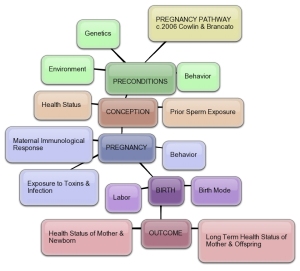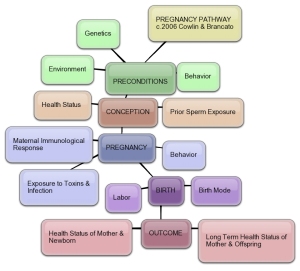What is Fetal Programming?
What is fetal programming? Every person living on earth was first exposed to a uterine environment that helped determine their lifetime health and development. The term for this phenomenon is fetal programming. It is a hot topic and deserves attention.
Accepting the importance of fetal programming places responsibility on the mother-to-be to do all she can to insure her body provides nutrients and oxygen to her growing infant while avoiding possible risks and toxins. At the same time, genetic and environmental factors contribute greatly to the potential for some disorders and problems that arise. Thus, we must be careful in assigning guidelines for acceptable behavior or blame for poor outcomes to pregnant women.
On the one hand, we can all see the negative consequences of something like fetal alcohol syndrome…clearly the result of maternal behavior. Is a pregnant woman whose baby has been damaged in this way guilty of abuse?
But, what if a mother is obese, eats poorly and ends up with an infant with a disturbed metabolism. Is this abuse? What if the mother has an infection that results in cerebral palsy? Or what if she lives near a highway and involuntarily inhales fumes that negatively affect the placenta?
How do you get a healthy baby? Of course, there are no guarantees. There remain many unknown factors that can affect the course and outcome of a pregnancy. Some factors we are aware of, such as avoiding certain fumes or chemicals. There are some behaviors we know can maximize the potential for a good outcome, such as eating adequate protein, aerobic conditioning and strength training. [Note for new readers…lots of these factors have been covered in our previous posts.]
But, what about all the things we don’t know about?
If these goats eat the wrong grass, will they go into labor?
Here is a cautionary tale: There is a species of goat that, if they eat a certain type of skunk grass on day 14 (and only day 14) of pregnancy, will not go into labor. Why? Plant toxins in this grass interfere with the development of a small portion of fetal brain, the paraventricular nucleus. This nucleus is involved in the signaling cycle of labor. Without it, the mother will not go into labor!
What are the take-home messages here?
- Probably no one is ever a perfect fetus…too many possible threats.
- There are some threats we can avoid…being lazy, over-eating, smoking.
- There are some threats we cannot avoid, so we do the best we can.
Do the best you can by your baby…aerobic fitness, good nourishment, sleep, good hygiene and de-stressing your life.















 Are you prepared to become a parent? One way to tell is to look at your environment…is it healthy? Are you living in a situation that you can count on? What about clean air, safe paint or safe food? What about water? What about people around you? Are they supportive? Does your environment help you stay healthy?
Are you prepared to become a parent? One way to tell is to look at your environment…is it healthy? Are you living in a situation that you can count on? What about clean air, safe paint or safe food? What about water? What about people around you? Are they supportive? Does your environment help you stay healthy?